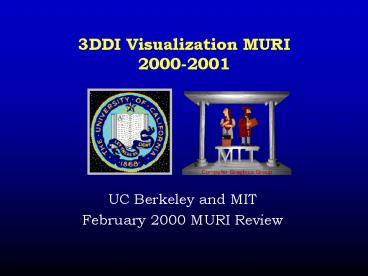3DDI Visualization MURI 20002001 PowerPoint PPT Presentation
1 / 19
Title: 3DDI Visualization MURI 20002001
1
3DDI Visualization MURI2000-2001
- UC Berkeley and MIT
- February 2000 MURI Review
2
Recap of 3DDI system organization
- Project pipeline
3D capture
Modeling, simulation
Rendering
3D Display
Application Exterior and Interior Urban
Environments
3
Previous review
- Increased emphasis on urban modeling
- Scale, complexity, throughput
- Attention to principled integration
- Particularly of indoor, outdoor dataand various
simulation engines
4
Overview Urban model acquisition
- Automation
- Automatic exterior calibration of imagery
- Generalization Aggregation
- 3D reconstruction, merging
- Texture, occlusion, relief estimation
- Collaboration with Fua (EPFL) and LeClerc (SRI)
- Symbolic window extraction
- Collaboration with Wang and Hansen (UMass)
- Scale and Throughput
- Data acquisition, distributed processing
- Input and Output Validation
- Sensor improvement surveying efforts
5
Overview Integration efforts
- Weekly UCB/MIT teleconferences in 1999
- Shared message archive, PC/Irix codebase
- Reciprocal visits Summer, Fall 1999
- Generalized database (Rick Bukowski)
- SYLIF automated furniture placement (Kari
Anne Kjolaas Laura Downs) - Princeton Radiosity (Mike Wittman)
- Indoor-outdoor visibility (Eric Brittain)
- Floorplan annotation and extrusion
- With MIT physical plant City of Cambridge
- Autostereoscopic display (Steve Benton)
6
Alignment is automation bottleneck
- Overview of end-to-end pipeline
- Recovering rotation and translationfor acquired
hemispherical images - Short-baseline techniques not applicable
- Exploit navigation informationlarge number
(1000s) of images - Tack decouple rotation, translationsolve
independently (w/ Matt Antone)
7
Generalization and Aggregation
- Several 3D reconstruction techniques
- Large planar surfaces (Coorg)
- Small surfels (Mellor)
- Bottom-up surface inferences (Chou)
- Aggregation phase (Cutler)
- Principled merging of algorithm outputsto
produce single consistent CAD model
8
Texture, Occlusion, Relief Estimation
- Fua and LeClercs mesh optimization
- Students Eric Amram, Stefano Totaro
- Added iterative occlusion masking
- Improved self-occlusion checking
- Significantly improved results
9
Symbolic Window Extraction
- Based on algorithm of Wang et al. (Proc. SPIE
97) - Oriented region-growing technique
- Applied to composite façade images
- After removal of occlusion, shadows
- Planned application to
- Mesh regularization (quantized depth)
- Model color from multiple distributions
10
Increasing Scale, Throughput
- Scale sensor, spatial infrastructure
- Sensor node time reduced to 1 minute from 5
minutes in 1998, including HDR - Input second MIT dataset, severalhundred nodes
across East Campus - Throughput map algorithms to parallel,
distributed Linux cluster - 1-32 CPUs with near-linear speedups
- Currently limited by I/O bandwidth
11
Campus datasets
East Campus
12
Validation
- Input (Mike Bosse)
- Survey waypoints to characterizeprecision,
accuracy of navigation sensor - Suppress sub-systems (GPS, inertial, odometry) to
gauge contribution of each - Output (Qixiang Sun)
- Synthetic inputs, idealized results
- Real inputs, optimization residuals
- Compare reconstructed models tosurveyed,
hand-solved models
13
Evaluation Criteria
- Throughput
- Complexity
- Fidelity (Geometric, Photometric)
- Adoption of tools and models by users
- Assessment of results by community
14
Connections to other communities
- MIT Physical Plant
- Well-maintained 2D CAD
- City of Cambridge Planning Dept.
- Surveying, GIS expertise/expectations
- MIT Depts of Architecture, Urban Planning
- GIS software, demographic data
15
Conclusions
- Emphasis on infrastructure, solid engineering,
scale, validation - Significant progress toward rapid, end-to-end
acquisition capability - Significant infrastructure and integration
efforts for simulation, use
16
Plans for coming year
- Improvements to City Scanning
- Larger scenes
- Faster end-to-end processing
- More robust, accurate results
- Continue integration efforts
- MURI pipeline (collaborators)
- MIT physical plant (customers)
17
City Scanning module improvements
- 10x area implies 10x datasize
- Data scaling, naming conventions
- Speed
- Pose-camera (Argus) improvements
- Parallel distributed processing pipeline
- Accuracy, validation
- 6-DOF raw navigation data
- Imagery control (exterior calibration)
- Derived feature points, edges, faces
- Relief extraction
- Symbolic windows
18
Integration efforts (MURI)
- Elaboration of interior spaces
- Increased symbolic content in DB
- Semi-automated furnishing, etc.
- Use of acquired phototextures
- Breadth of simulation connections
- Lighting, NOW back end
- Enhanced dynamics
- Multi-user operation
- Adoption of segmentation algorithms
- Extended indoor-outdoor visibility
- Visible, occlusion volumes algebra
19
Integration efforts (MIT Phys. Plant)
- Goal compile entire campus into 3D
- Determine required metadata
- Robust large-scale conversion process
- Registration with scanned exteriors
- User-based model personalization
- Deliverable artifacts and tools
- Compilation of revised floorplans
- Shortest path planning (abled, disabled)
- Virtual campus exploration, rendering

